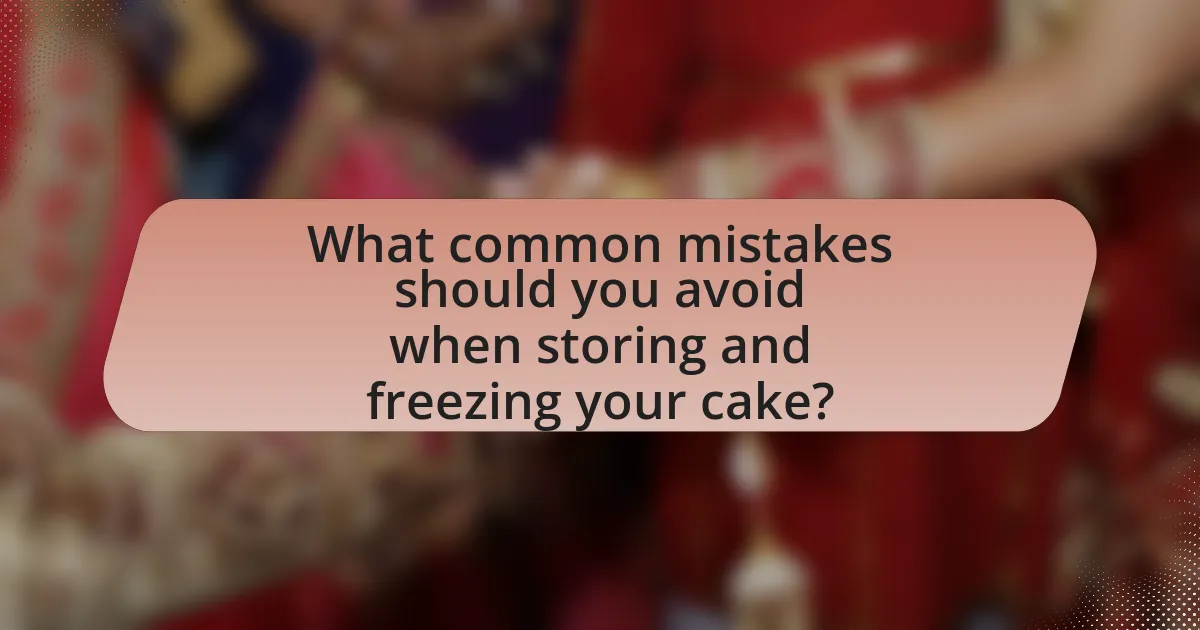The article provides essential tips for storing and freezing a DIY wedding cake to maintain its freshness and quality. It outlines best practices for storage, including the importance of wrapping the cake properly and the ideal temperature and humidity levels for preservation. The article also discusses how different types of cakes and frostings affect storage methods, as well as common mistakes to avoid. Additionally, it offers guidance on effectively freezing cakes, including preparation steps, thawing techniques, and the risks associated with certain ingredients. Overall, the article serves as a comprehensive resource for ensuring that a homemade wedding cake remains delicious and safe for consumption.

What are the best practices for storing your DIY wedding cake?
The best practices for storing your DIY wedding cake include keeping it in a cool, dry place, ideally in the refrigerator, and ensuring it is well-wrapped to prevent drying out. Proper storage involves using plastic wrap or an airtight container to maintain moisture and freshness. Additionally, if the cake is frosted, it should be stored in a way that prevents the frosting from being damaged, such as placing it in a cake box or covering it with a dome. Cakes can typically be stored in the refrigerator for up to a week, while freezing is an option for longer storage, allowing cakes to be kept for several months if wrapped securely in plastic wrap and aluminum foil.
How should you prepare your cake for storage?
To prepare your cake for storage, first ensure it is completely cooled to prevent condensation. Once cooled, wrap the cake tightly in plastic wrap to protect it from air exposure and moisture loss. For added protection, place the wrapped cake in an airtight container or a resealable plastic bag. This method helps maintain the cake’s freshness and prevents it from absorbing odors from the refrigerator or freezer. Properly stored, a cake can last for several days at room temperature or up to three months in the freezer.
What materials do you need for proper cake wrapping?
For proper cake wrapping, you need plastic wrap, aluminum foil, and a sturdy cake box. Plastic wrap provides an airtight seal to prevent moisture loss, while aluminum foil adds an extra layer of protection against freezer burn. A sturdy cake box offers structural support and keeps the cake safe from external damage during storage. These materials ensure that the cake remains fresh and intact, preserving its quality for later enjoyment.
How does the type of cake affect storage methods?
The type of cake significantly affects storage methods due to variations in moisture content, ingredients, and structure. For instance, butter-based cakes, which are denser and retain moisture, can be stored at room temperature for a few days, while cream-filled or frosted cakes require refrigeration to prevent spoilage. Additionally, fruit cakes, known for their low moisture content and high sugar levels, can be stored in a cool, dry place for extended periods without refrigeration. This differentiation in storage methods is crucial to maintain the cake’s texture and flavor, ensuring it remains safe and enjoyable for consumption.
What are the ideal storage conditions for a wedding cake?
The ideal storage conditions for a wedding cake involve keeping it in a cool, dry place at room temperature, ideally between 68°F and 72°F (20°C to 22°C). This temperature range helps maintain the cake’s texture and flavor while preventing spoilage. Additionally, the cake should be covered with a cake box or plastic wrap to protect it from air exposure and contaminants. Storing the cake in a refrigerator is not recommended unless it contains perishable fillings, as refrigeration can dry out the cake and alter its taste. These conditions ensure that the wedding cake remains fresh and enjoyable for the celebration.
How does temperature impact cake freshness?
Temperature significantly impacts cake freshness by influencing moisture retention and microbial growth. When cakes are stored at higher temperatures, they tend to dry out more quickly due to increased evaporation of moisture, leading to a loss of texture and flavor. Conversely, cooler temperatures help maintain moisture levels, preserving the cake’s softness and taste. Research indicates that cakes stored at room temperature can become stale within a few days, while those refrigerated can last longer, although refrigeration may alter the texture. Proper storage at optimal temperatures, typically between 20-22 degrees Celsius for short-term and below 4 degrees Celsius for longer-term storage, is essential for maintaining cake freshness.
What humidity levels are best for cake storage?
The best humidity levels for cake storage are between 30% and 50%. This range helps to maintain the cake’s moisture without promoting mold growth or causing it to dry out. High humidity can lead to a soggy texture and spoilage, while low humidity can result in a dry cake. Proper storage conditions within this humidity range ensure the cake remains fresh and flavorful for an extended period.

How can you effectively freeze your DIY wedding cake?
To effectively freeze your DIY wedding cake, first ensure it is completely cooled and wrapped securely. Use plastic wrap to cover the cake tightly, followed by aluminum foil for added protection against freezer burn. This method prevents moisture loss and preserves the cake’s texture. Additionally, freezing the cake in individual slices can make it easier to thaw and serve later. According to the USDA, properly wrapped cakes can be stored in the freezer for up to a year without significant loss of quality.
What steps should you follow to freeze your cake properly?
To freeze your cake properly, first allow it to cool completely after baking. Once cooled, wrap the cake tightly in plastic wrap to prevent freezer burn. Next, place the wrapped cake in an airtight container or a resealable freezer bag for added protection. Label the container with the date and type of cake for easy identification. Finally, freeze the cake for up to three months for optimal freshness. These steps ensure that the cake retains its moisture and flavor during freezing, making it ready for future use.
How long can you freeze a wedding cake without losing quality?
You can freeze a wedding cake for up to one year without losing quality. Properly wrapping the cake in plastic wrap and aluminum foil helps maintain its moisture and flavor during freezing. Studies indicate that cakes retain their taste and texture best when frozen for this duration, as freezing slows down the degradation of ingredients.
What is the best way to thaw a frozen wedding cake?
The best way to thaw a frozen wedding cake is to transfer it from the freezer to the refrigerator and allow it to thaw slowly for 24 hours. This method helps maintain the cake’s texture and flavor by preventing condensation from forming on the surface. Thawing in the refrigerator also minimizes the risk of spoilage, as the cake remains at a safe temperature throughout the process.
What types of cakes are suitable for freezing?
Cakes that are suitable for freezing include butter cakes, pound cakes, and sponge cakes. These types of cakes have a dense structure that holds up well during the freezing process, maintaining their texture and flavor upon thawing. Additionally, cakes that are un-frosted or have a simple frosting, such as buttercream, are ideal for freezing, as they can be wrapped tightly to prevent freezer burn. Research indicates that freezing can extend the shelf life of cakes by several months without significant loss of quality, making it a practical option for preserving homemade cakes.
How do different frosting types affect freezing?
Different frosting types significantly affect freezing due to their composition and moisture content. Buttercream frosting, for example, freezes well because its fat content helps maintain texture and flavor, allowing it to be stored for up to three months without significant quality loss. In contrast, whipped cream frosting does not freeze as effectively; it can separate and lose its airy texture upon thawing, making it less suitable for long-term storage. Additionally, cream cheese frosting may also experience texture changes when frozen, as the moisture can lead to a grainy consistency after thawing. These characteristics highlight the importance of selecting the right frosting type for freezing to ensure the best quality of the cake upon defrosting.
What are the risks of freezing certain cake ingredients?
Freezing certain cake ingredients can lead to texture and flavor degradation. For example, eggs may become rubbery, while dairy products like cream can separate and curdle upon thawing. Additionally, fruits can lose their structural integrity, resulting in a mushy consistency. These changes can negatively impact the overall quality of the cake, making it less enjoyable.

What common mistakes should you avoid when storing and freezing your cake?
When storing and freezing your cake, avoid the common mistakes of not allowing the cake to cool completely before wrapping, failing to use proper airtight packaging, and neglecting to label the cake with the date. Allowing the cake to cool completely prevents moisture buildup, which can lead to sogginess. Using airtight packaging, such as plastic wrap or a sealed container, protects the cake from freezer burn and preserves its flavor and texture. Labeling the cake with the date ensures you consume it within a safe timeframe, as cakes are best enjoyed within three months of freezing.
What are the most frequent errors in cake storage?
The most frequent errors in cake storage include improper wrapping, incorrect temperature settings, and inadequate moisture control. Improper wrapping, such as using plastic wrap that is not airtight, can lead to the cake drying out or absorbing odors from the fridge. Incorrect temperature settings, like storing a cake in a refrigerator that is too cold, can cause the cake to become hard and lose its texture. Inadequate moisture control, such as failing to use a simple syrup on the cake layers, can result in a dry cake. These errors can significantly affect the cake’s taste and texture, making proper storage essential for maintaining quality.
How can improper wrapping affect cake quality?
Improper wrapping can lead to a decline in cake quality by causing it to dry out or become stale. When a cake is not adequately wrapped, air exposure can result in moisture loss, leading to a dry texture and loss of flavor. Additionally, inadequate wrapping may allow the cake to absorb unwanted odors from the environment, negatively impacting its taste. Studies indicate that cakes stored in airtight containers or properly wrapped retain their moisture and flavor significantly better than those that are not, highlighting the importance of proper wrapping techniques for maintaining cake quality.
What signs indicate that a cake has been improperly stored?
Signs that indicate a cake has been improperly stored include visible mold, a dry or hard texture, and an off smell. Mold growth on the surface of the cake signifies exposure to moisture or improper sealing, while a dry or hard texture indicates that the cake has lost moisture due to inadequate wrapping or storage conditions. An off smell can suggest spoilage or contamination, often resulting from prolonged exposure to air or unsuitable temperatures. These signs confirm that the cake has not been stored correctly, impacting its quality and safety for consumption.
What tips can help ensure your cake remains fresh and delicious?
To ensure your cake remains fresh and delicious, store it in an airtight container at room temperature or refrigerate it if necessary. Keeping the cake in an airtight container prevents moisture loss and protects it from external odors, which can affect flavor. For longer storage, wrap the cake tightly in plastic wrap and then in aluminum foil before freezing, as this method can preserve its texture and taste for up to three months. Additionally, avoid cutting the cake until serving time to maintain its freshness, as each cut exposes more surface area to air, which can lead to drying out.
How can you maintain flavor and texture during storage?
To maintain flavor and texture during storage, wrap the cake tightly in plastic wrap and then place it in an airtight container. This method prevents moisture loss and protects the cake from absorbing odors from the freezer or refrigerator. Studies show that cakes stored in airtight conditions retain their moisture and flavor better than those left uncovered, as exposure to air can lead to staleness and dryness. Additionally, freezing the cake can preserve its texture and taste for several months, as the low temperatures inhibit the growth of bacteria and mold.
What are the best practices for serving a previously frozen cake?
To serve a previously frozen cake effectively, first, allow the cake to thaw in the refrigerator for several hours or overnight. This gradual thawing process helps maintain the cake’s moisture and texture. After thawing, remove the cake from the refrigerator and let it sit at room temperature for about 30 minutes before serving to enhance flavor and improve the texture. It is also advisable to avoid refreezing the cake once it has been thawed, as this can negatively impact its quality. These practices ensure that the cake retains its intended taste and consistency, making it enjoyable for consumption.
